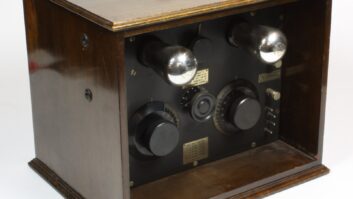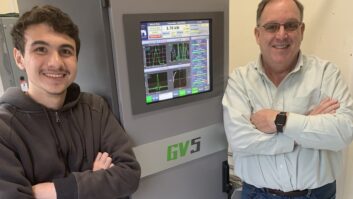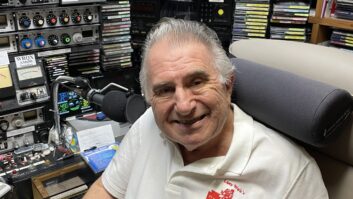The device that heralded the beginning of the 20th century electronics industry first saw the light of day in late 1906, just over a century ago. This was the triode electron tube, or audion, as its inventor called it.
To those of us who lived and worked with vacuum tubes at least some time during our careers, Lee de Forest’s invention seems both simple and obvious: a glowing metal filament (cathode) provides a source of electrons that are attracted to a positively charged plate or anode (de Forest initially called it a “wing”). Interposed between the cathode and anode structures is a “less than solid” grid. (The grid in the original tube was simply a piece of wire bent back and forth in a zigzag manner. It later evolved into a more efficient helix of wire surrounding the filament or cathode.)
By varying the voltage on the grid, the stream of electrons being drawn to the anode is modulated. A small grid voltage can effect an appreciable change in a plate circuit load resistor, and the voltage developed across it. It amplifies!
Simple!
However, it took a patent suite to force its invention, five to six additional years to turn it into a practical device, the work of another fabled engineer to explain its workings, and several legal skirmishes to clear the path for its commercial use.
The concept of the electron tube goes back quite a bit before de Forest. Geissler tubes, Crookes tubes, Lenard tubes, x-ray tubes, early cathode ray tubes and others all involved sealing metal electrodes into a glass envelope or tube and removing a certain amount of air from the space inside.
It began with Edison
Thomas Edison must be given credit for the creation of the “hot cathode” tube — he sealed a metal plate inside one of his electric lamps and noted a unidirectional flow of current when the lamp’s filament incandesced. He received a patent on this “Edison effect,” but did not try to commercialize it, or spend much time in trying to understand what was happening.
Later, a British scientist, John Ambrose Fleming decided to try it out as a detector of radio frequency energy and learned that it worked very well for that purpose. He dubbed it the “oscillation valve” and received a patent on his discovery. (Electron tubes have always been known as valves in England.)
Enter de Forest.
After graduating from Yale’s Sheffield Scientific School in 1899, Lee de Forest had hoped to work in Nikola Tesla’s laboratory but received no offer. Instead, he moved through a series of low-paying introductory positions in the field of telephony and wireless before meeting a less-than-honest stock promoter, Abraham White. In a short time, White had incorporated the De Forest Wireless Telegraph Company in New Jersey, with himself as president and with young de Forest serving as vice president and scientific director.
In truth, White was more interested in making money than furthering the state of wireless communications, but he had to have something to show potential investors, so a number of wireless telegraph stations were constructed in the Eastern United States. The company set up a particularly impressive display of wireless at the 1904 St. Louis World’s Fair.
Fessenden
Many problems beset the operation of the De Forest Wireless Telegraph Company. Among these was legal action taken by Reginald Fessenden over de Forest’s unauthorized use of Fessenden’s electrolytic detector. In 1906, after three years in the courts, Fessenden was awarded a judgment and effectively put the de Forest company out of business. White was quick to reorganize under another name and transfer assets, so as to deny Fessenden the monetary penalty the court assessed. There was no place for de Forest in this new venture; he was terminated with a small amount of severance pay and a solitary invention he’d been working on that White believed to be worthless. This was a detector of radio waves that did not infringe on Fessenden’s device.
Exactly how de Forest arrived at his idea for a detector is a matter of conjecture. As mentioned, Edison had discovered that a negative voltage could move through the empty space in the specially constructed electric lamp. Later, Fleming adapted this principle to demodulate RF energy and published his findings in 1905.
With Fessenden’s lawsuit looming, it is to be imagined that de Forest quickly began searching for other technology to replace that crucial (and borrowed) part of the radio system he was using.
By his accounting, de Forest had first tried detecting radio signals by placing electrodes in an open gas flame. While this worked, the detector was only as stable as the air currents around it and could not be transformed into a commercial device.
It could be assumed that de Forest made the crucial “jump” in his road to invention by replacing the gas flame with an electrical one, sealed within a glass shell.
Enter McCandless
It is reported that in the fall of 1906, Henry McCandless, a New York City manufacturer of small electric lamp bulbs, was approached by an assistant of de Forest’s and asked to fabricate what amounted to a Fleming valve.
In a matter of weeks, de Forest unveiled his latest development at a meeting of the American Institute of Electrical Engineers in New York City. The date was Oct. 26, 1906. De Forest used the word “audion” to describe this new detector.
At this point in time, it appears that de Forest had merely reverse engineered yet another invention.
However, within the month, he enhanced the oscillation valve or audion into something unique and patentable.
How de Forest came upon the idea that jumpstarted the electronics industry will probably never be known with certainty. Why he did it may be clear in light of the audion’s closeness to Fleming’s valve.
De Forest had experimented with using multiple electrodes in his flame detector experiments. Perhaps this was the genesis of his invention; perhaps not.
He had also been experimenting with the use of a battery, or batteries, in connection with the Fleming diode. Perhaps he was curious about what would happen if he used multiple electrodes as he had done in the lamp detector. Perhaps he just wanted to make it appear to be something other than a direct knock-off of Fleming’s device. His exact reasons will never be known.
During that November, in an attempt to either replicate his work with the flame detector, or possibly to make his device different from Fleming’s, de Forest sought a patent on a device that consisted of a filament, an anode and a control electrode of sorts (not a grid). Such a tube could not have provided de Forest with any useful gain. (However, years later, this principle of “gridless control” was successfully adopted by Heintz & Kaufman Ltd. and was the basis for their “Gammatron” tubes.)
De Forest kept up his experimentation and on Nov. 25, 1906, he had McCandless incorporate a grid structure into the experimental lamp devices he’d been ordering.
Genius?
Was it a stroke of genius, or just a plodding attempt to avoid infringement on Fleming’s detector?
It doesn’t really matter. This was that bit of tinkering, experimentation, innovating, developmental engineering or just plain luck that put de Forest over the top.
This was the small step that immortalized de Forest and placed him among the top inventors of the century.
Instead of merely detecting, the addition of the third element allowed the audion to amplify. If it could amplify, then it could oscillate. The possibilities for the new device appeared to be nearly limitless.
However, all of this was to come somewhat later. At the end of 1906, the audion was far from perfect and de Forest was woefully ignorant as to how it worked. This is so stated in his patent application.
He assumed that ionized gas was somehow involved in moving charges through space, hence the name aud–ion. In fact, he rationalized that if too great a vacuum was created in processing the audion, the tube could not work.
This resulted in the audions produced by McCandless being quite gassy and of limited use. (The chief customers were radio amateurs, and the early tubes sold for $5.) If more than a few tens of volts were applied to the wing (plate), then the residual gas would ionize and render the tube useless until the potential was removed.
Also, carbon or pure tungsten are not the most copious electron emitters and early adopters of de Forest’s triode would frequently burn out the filament in their efforts to squeeze more performance from the little amplifier, resulting in product returns to McCandless.
For this and other reasons, McCandless was not that excited about manufacturing audions for de Forest, but continued to do so for some time. He was in part responsible for several changes and improvements to the device during the next several years of its existence.
It took Edwin H. Armstrong to fully analyze the operation of the de Forest audion and put forth the correct theory of its operation.
De Forest eventually sold rights to his invention. Engineers and scientists at both Western Electric and General Electric “took it from there” and shaped the primitive little device into the workhorse that drove the radio, recording, television, computing and numerous other industries until the invention of the transistor began to eclipse it more than 50 years later.
De Forest was honored in 1922 with the Institute of Radio Engineer’s Medal of Honor in recognition of his invention and other work in the field of radio.
Later in his life, de Forest served a term as president of the IRE (1930) and in 1946 received the AIEE’s Edison Medal for his development of the vacuum tube.
Although de Forest died at the age of 87 in 1961, his invention lives on. Even though the vacuum tube is officially 100 years old now, it is has not been forgotten and pushed out of the way. Several companies still manufacture tubes and many audiophiles claim that tube technology is the only way with which to reproduce high quality audio.
Happy birthday!
This article was prepared for the IEEE Broadcast technology Society Newsletter.












